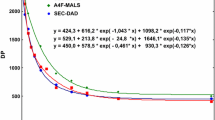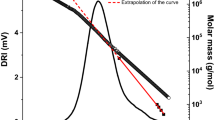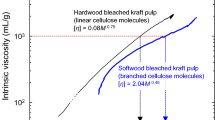Abstract
Norway spruce (Picea abies) cellulose samplesdissolved in lithium chloride/N,N-dimethyl-acetamide(LiCl/DMAc) covering a wide range of average molecular weights were analyzed bysize exclusion chromatography (SEC) and multi-angle laser light detection(MALLS). The molecular weight distribution of the samples was compared to themolecular weight distribution of cotton linters cellulose samples. To obtaincomplete dissolution of high-molecular-weight wood cellulose, previouslypublished procedures for dissolving cellulose in LiCl/DMAc were modified. SECseparation was performed using macroporous monodisperse polymer particles ascolumn matrix. The refractive index increment (dn/dc)μ forcellulose in 0.5% LiCl/DMAc was found to be 0.104. The radius of gyration,RG, of cellulose in 0.5% LiCl/DMAc depended on the molecular weight,M, according to the relation RG ∝ M0.55. Celluloseprepared from sprucewood by the sulfite cooking process had a broad molecularweight distribution compared to cotton linters cellulose.
Similar content being viewed by others
References
Altieri A.S., Hinton D.P. and Byrd R.A. 1995. Association of biomolecular systems via pulsed-field gradient NMR self-diffusion measurements. J. Am. Chem. Soc. 117: 7566–7567.
Austin P.R. 1977. Deutsches Patentamt. Offenlegungsschrift 2,707,164.
Christensen B.E., Mylir M.H., Aune O., Hagen S., Berge A. and Ugelstad J. 1996. Macroporous, monodisperse particles and their application in aqueous size exclusion chromatography of high molecular weight polysaccharides. Carbohydr. Polymers 29: 217–223.
Dawsey T.R. and McCormick C.L. 1990. The lithium chloride/dimethylacetamide solvent for cellulose – A literature review. J. Macromol. Sci. – Rev. Macromol. Chem. Phys. C30: 405–440.
Ekmanis J.L. 1987. Abstracts, The Pittsburgh Conference and Exposition, Atlantic City, NJ, Abstract no. 783.
Huang R.Y.M. and Jenkins R.G. 1969. Investigations on molecular weight distributions in wood cellulose using gel permeation chromatography. Tappi J. 52: 1503–1507.
Kordsachia O., Paff P. and Sixta H. 1999. Cellulose isolation from different raw materials. Papier 53: 96–108.
Kvernheim A.L. and Lystad E. 1989. Size-exclusion chromatography and methylation analysis of cellulose in N,N-dimethylacetamide/ LiCl. Acta Chem. Scandinavica 43: 209–211.
Lauriol J.M., Comtat J., Froment P., Pla F. and Robert A. 1987. Molecular-weight distribution of cellulose by online size exclusion chromatography – low-angle laser-light scattering. 2. Acid and enzymatic hydrolysis. Holzforschung 41: 165–169.
Lindholm C. 1987. Effect of pulp consistency and pH in ozone bleaching part 2. Lignin removal and carbohydrate degradation. 1987 International Oxygen Delignification Conference: 155–163.
McCormick C.L. 1981. U.S. Patent 4,278,290.
McCormick C.L., Callais P.A. and Hutchinson B.H. 1985. Solution studies of cellulose in lithium chloride and N,N-dimethylacetamide. Macromolecules 18: 2394–2401.
Morgenstern B. and Kammer H.-W. 1996. Solvation in cellulose-LiCl-DMAc solutions. Trends Polymer Sci. 4: 87–92.
Morgenstern B. and Kammer H.-W. 1999. On the particulate structure of cellulose solutions. Polymer 40: 1299–1304.
Morgenstern B. 2000. Cellulose in Lösungen und Polymermischungen. Habilitationsschrift, Technische Universität, Dresden, Germany.
Nevell T.P. and Zeronian S.H. (eds) 1985. Cellulose Chemistry and its Applications. Ellis Horwood, Chichester, UK.
Potthast A., Rosenau T., Buchner R., Ebner G., Röder T. and Kosma P. 2000. The Cellulose Solvent System DMAc/LiCl Revised: The Effect of The Water Content. European Workshop on Lignocellulosics and Pulp 2000 (EWLP), Bordeaux, France, pp. 29–32.
Rydholm S.A. 1966. Pulping Processes. Wiley Interscience Publishers, New York.
Schelosky N., Röder T. and Baldinger T. 1999. Molecular mass distribution of cellulosic products by size exclusion chromatography in dimethylacetamide/lithium chloride. Das Papier 12: 728–738.
Schult T., Moe S.T., Hjerde T. and Christensen B.E. 2000. Size exclusion chromatography of cellulose dissolved in LiCl/DMAC using macroporous monodisperse poly(styrene-co-divinylbenzene) particles. J. Liquid Chromatogr. Related Technol. 23: 2277–2288.
Silva A.A. and Laver M.L. 1997. Molecular weight characterization of wood pulp cellulose: dissolution and size exclusion chromatographic analysis. Tappi J. 80: 173–180.
Sjöholm E., Gustafsson K., Pettersson B. and Colmsjö A. 1997. Characterization of the cellulosic residues from lithium chloride N,N-dimethylacetamide dissolution of softwood kraft pulp. Carbohydr. Polymers 32: 57–63.
Sjöholm E. 1999. Characterisation of kraft pulps by size-exclusion chromatography and kraft lignin samples by capillary zone electrophoresis. Ph.D. Thesis, Royal Institute of Technology, Stockholm, Sweden.
Sjöström E. 1993. Wood Chemistry: Fundamentals and Applications. 2nd edn. Academic Press, Inc., New York.
Sperling L.H. 1992. Introduction to Physical Polymer Science. 2nd edn. John Wiley and Sons, Inc., New York.
Striegel A.M. and Timpa J.D. 1996. Size exclusion chromatography of polysaccharides in dimethylacetamide-lithium chloride. ACS Symposium Series 635: 366–378.
Striegel A.M. 1997. Theory and applications of DMAc/LiCl in the analysis of polysaccharides. Carbohydr. Polymers 34: 267–274.
Timpa J.D. 1991. Application of universal calibration in gel-permeation chromatography for molecular-weight determinations of plant-cell wall polymers – cotton fiber. J. Agricult. Food Chem. 39: 270–275.
Turbak A.F., El-Kafrawy A., Snyder F.W. and Auerbach A.B. 1981. U.S. Patent 4,302,252.
Turbak A.F. 1983. Newer cellulose solvent systems. In: Soltes E.J. (ed.), Wood and Agricultural Residues. Academic Press, New York, pp. 87–99.
Author information
Authors and Affiliations
Rights and permissions
About this article
Cite this article
Schult, T., Hjerde, T., Inge Optun, O. et al. Characterization of cellulose by SEC-MALLS. Cellulose 9, 149–158 (2002). https://doi.org/10.1023/A:1020139409903
Issue Date:
DOI: https://doi.org/10.1023/A:1020139409903




